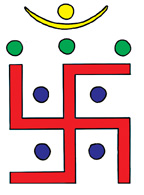Worship is an act of reverence, of giving or acknowledging worth to something/someone beyond yourself. In this way, despite the fact that Jains do not have a central God(s), Jains offer worship to the 24 Tirthankaras. But the Tirthankaras were humans, right? How does one worship a human?
First we must understand the Jain attitude toward the Tirthankaras. The title “Tirthankara” means “ford-maker,” in other words, one who has not only crossed the sea of samsara (rebirth), but who has taught the way to the people as well. Lord Mahavira was the 24th and last Tirthankara of his age. Jain devotees therefore offer reverence to these beings for their character and accomplishments. They do not pray for help or favor (one who has reached moksha, or liberation, is beyond such activities), but only wish to become more like the Tirthankaras so that they might reach the same destination.
 These idols provide a focal point for many Jain devotees while remembering the actions and characteristics of each Jina (one who has conquered inner and outer karmas). Like a kid with a poster of their favorite band or athlete, a Jain devotee looks to each Jina as an exemplar of a perfect life, one that leads to moksha.
These idols provide a focal point for many Jain devotees while remembering the actions and characteristics of each Jina (one who has conquered inner and outer karmas). Like a kid with a poster of their favorite band or athlete, a Jain devotee looks to each Jina as an exemplar of a perfect life, one that leads to moksha.
So what is Jain worship like?
Well to start, not every Jain is the same in this regard. There are some sects within the two major Jain divisions (Svetambara and Digambara) that do not believe in the use of idols. These are the Taranapantha, Sthanakvasi, and Tera panthi. For the sects which do not believe in idol worship, emphasis is placed on study of scripture, silent prayers, and meditation. I personally have no idols this month and so I utilize this form of practice as a Jain. I study the life of the Tirthankaras, try to cultivate my daily living according to Jain philosophy, and spend as much time in meditation and contemplation of Jain principles as possible.
For those who utilize idols, daily worship may occur in either a sacred space in the home or in a community temple. Worship within any context is called puja. Home puja is often very simple. Often there is at least one Jina idol upon a dedicated shelf or altar. A devotee will shower, dress in simple white or special clothing for the puja and enter the space with “Namo Jinanam” which means “I bow to the Jina.” After this greeting, one may repeat “Nisihii” three times to help remove outside thoughts and bring focus to worship.
At this time, a devotee might bow and recite the most important mantra in the Jain faith; the Navkar Mantra.
Namo Arihantanam (I bow to Arihanta)
Namo Siddhanam (I bow to Siddha)
Namo Ayariyanam (I bow to Acharya)
Namo Uvajjhayanam (I bow to Upadhyaya)
Namo Loe Savva-sahunam (I bow to Sadhu and Sadhvi)
Each of these represent those in the Jain way that have reached moksha, destroyed karmas, teach the Jain philosophy, or are on the monastic path toward moksha. By showing respect toward these individuals, a devotee commits themselves to the path.
Beyond these salutations, one’s puja can be as simple or elaborate as they wish. Some may shift into silent prayers commemorating the lives of these individuals and dedicating themselves to observing Jain practices. Others might sit in meditation for Pratikraman, which is an act of penance for negative actions and a re-commitment to the Jain way. Those who visit the temple or have idols in their home may circle the idol three times and perform the Snatra puja (ritual bathing of the idol which represents the bathing of the Tirthankaras by the gods at birth). Other rituals involve removing past karmas and honoring the five praiseworthy beings mentioned in the Navkar mantra.
Next, offerings are made in front of the idols which include fruits, flowers, or grain (the flower and fruit must have fallen naturally). Rice is often presented in the shape of a swastika (not the Nazi version) which represents the four types of rebirth: heavenly beings, human, lower creatures, and creatures of hell). Three dots rest above the four-sided symbol which represent the Three Jewels of Right Faith, Right Knowledge, and Right Conduct. Above the three dots is a final dot and a crescent denoting liberation (moksha).

Once offerings are given, if in the presence of monks and nuns, salutations are given in the form of the Chaitya Vendana. This form offers praise to the monastic order, the Tirthankaras, penance for any harm done to creatures on the way to the temple, and a promise to uphold the Jain philosophy. Worship is concluded by aarti, whichis the act of waving a five-fold light or lamp in front of the image.
This is a simple offering of Jain ritual and worship. Although there are many different ways for worship in the Jain faith, some of which do not use idols, there is little concept of right and wrong. Jains of different sects often worship in the same temple in the West. For the most part, the divisions are superficial regarding practice, although the doctrinal and philosophical practices are very similar. The various sects are viewed as compliments to one another, showing a balanced and complete Jain way rather than competitive ideologies.


